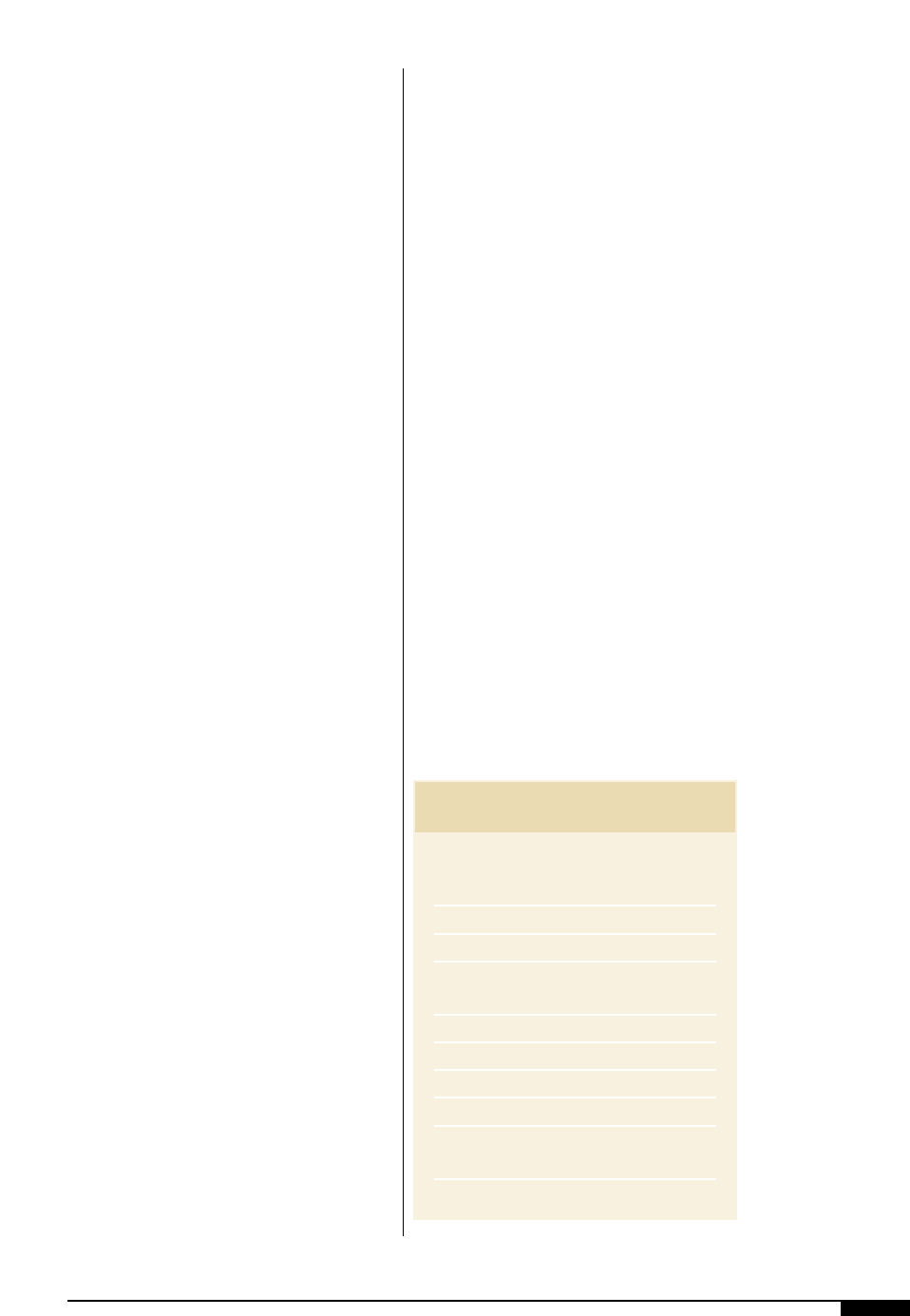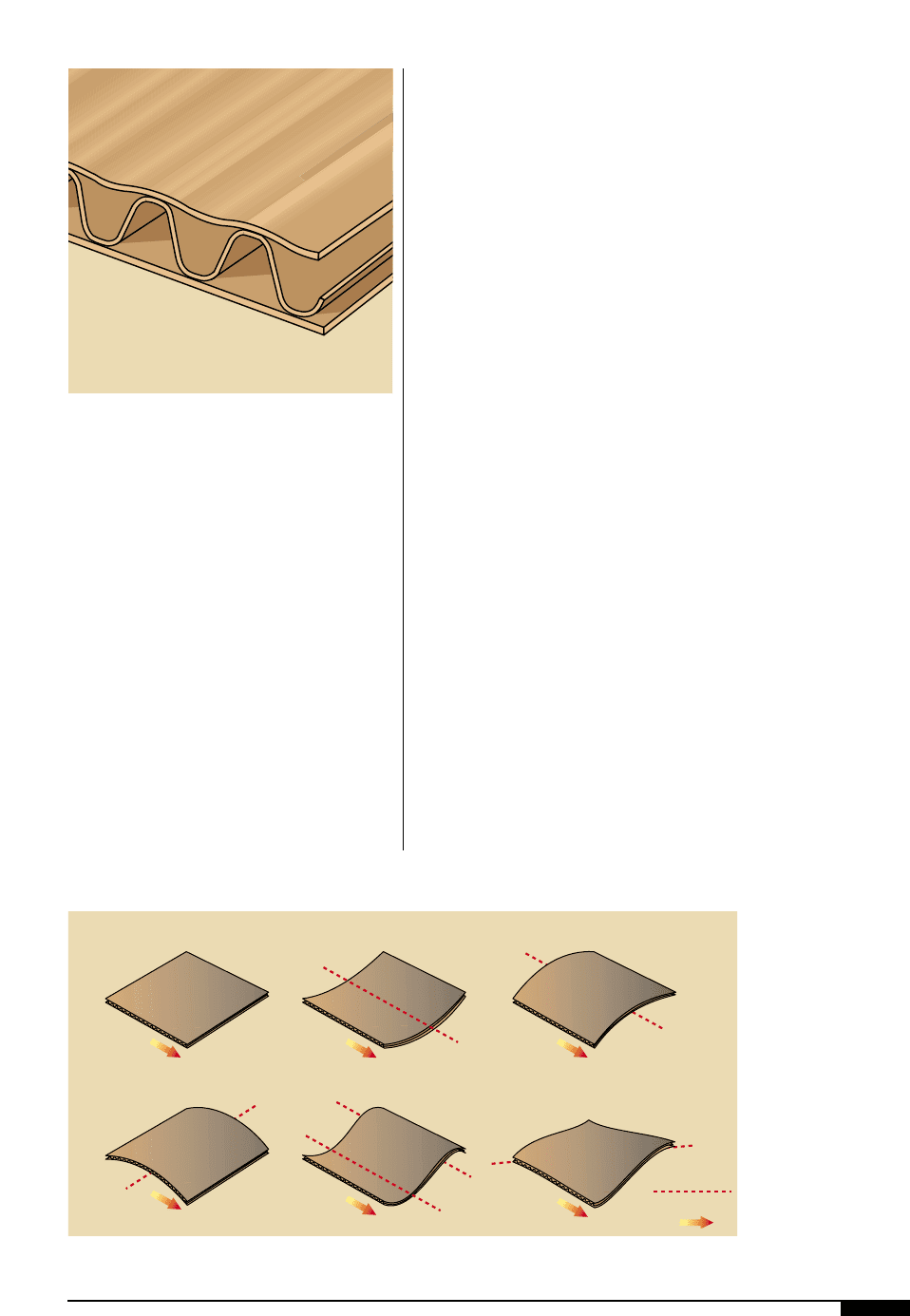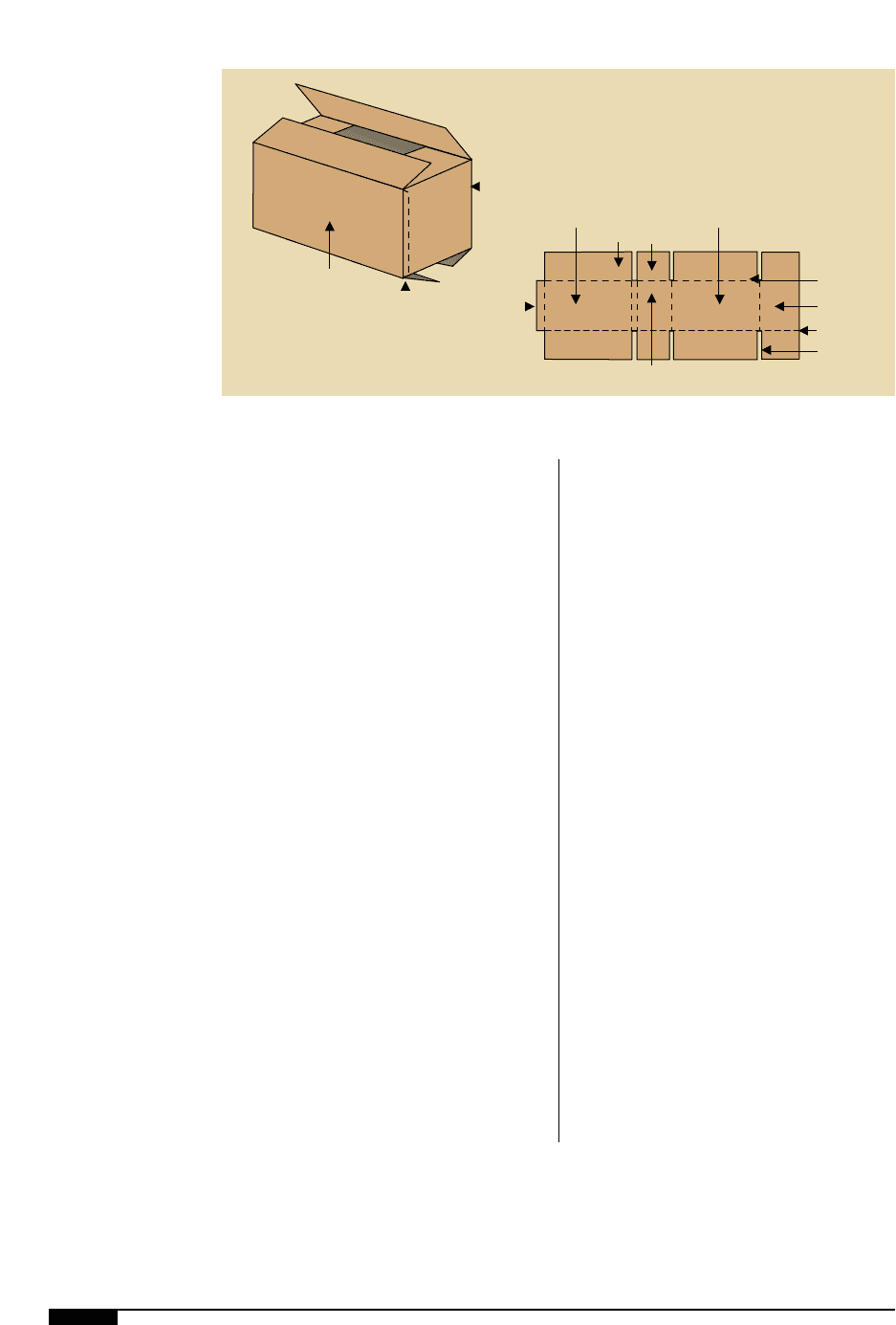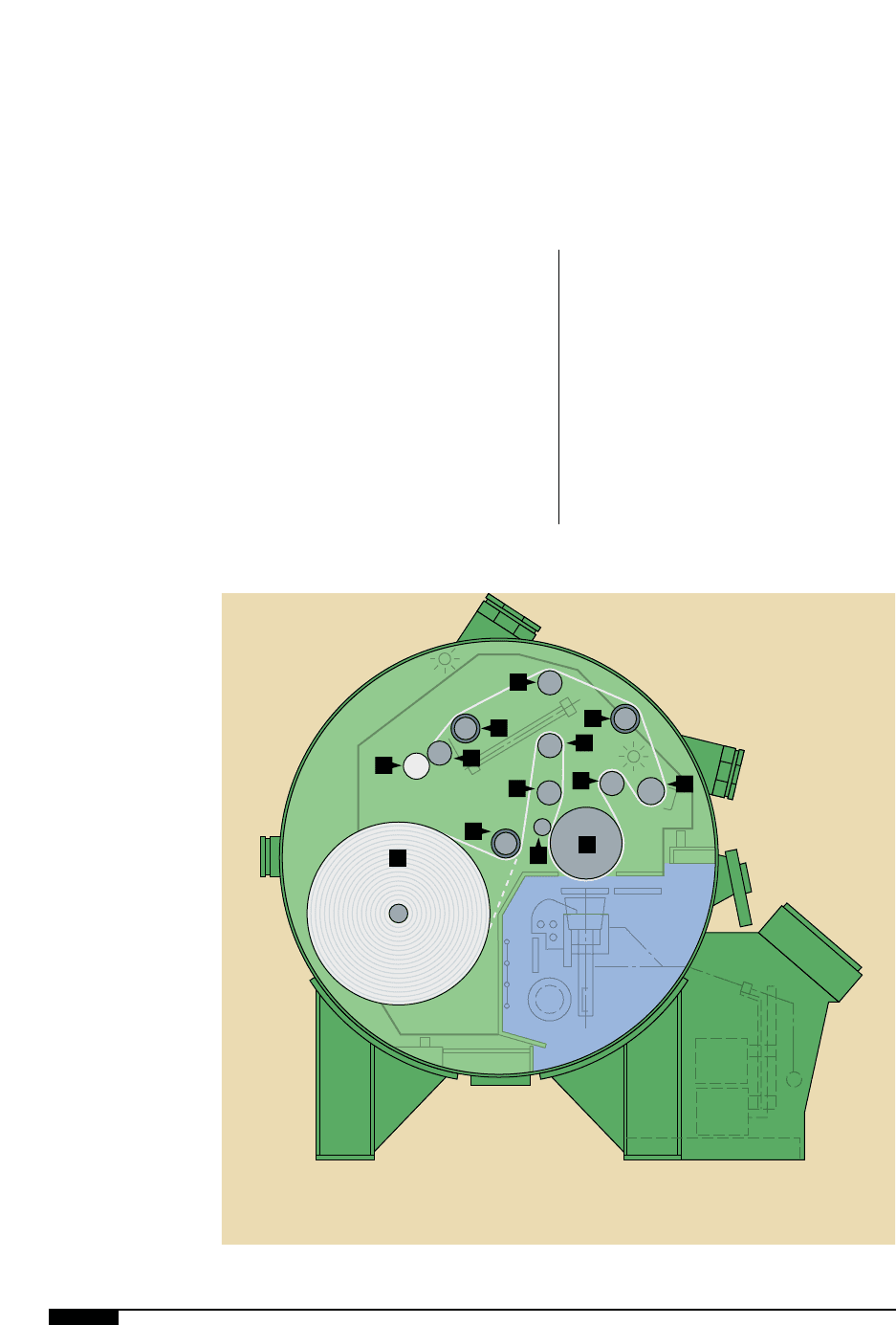FTA (изд-во). Flexography: Principles And Practices. Vol.1-6
Подождите немного. Документ загружается.


much stronger and stiffer corrugated boards.
The terms “inside liner” and “outside liner”
refer to the orientation of the liner with
respect to the shipping container. Some-
times, a better-quality liner is used on the out-
side surface for improved printing. Today
there are perhaps as many as 50 different
specifications for the outside printing sur-
face of the facing liner, from plain kraft to
high-holdout bleached and coated material.
One of the major concerns of the box man-
ufacturer, which also has a major effect on
the printer, is the type and integrity of the
board construction. Presuming that the bond
is made properly between the medium and
the liner, the most important factor in the
value of the corrugated container is the
integrity of the flutes. The flutes provide the
necessary flat crush strength of the box; they
provide the resiliency that absorbs the
shocks of shipping and handling. It is the flut-
ing concept that created the corrugated box
industry. The flutes provide the protection to
the contents of the corrugated container. If
the flutes fail to support their proper load,
the box fails to meet its primary function –
protection.
The A-flute has the highest flute height,
with a greater space between each flute.
Corrugated board constructed with the A-
flute is susceptible to crushing and is not
suitable for heavier products. The other
flutes have more and smaller flutes per foot
Table 22). This construction enables the cor-
rugated packages to withstand a crushing
force and still protect their contents. Smaller
flutes, such as F, N and micro flutes, have
been developed for the small-container mar-
ket, and provide a much smoother printing
surface.
DEFECTS
There are many different defects that can
be generated during the corrugating process.
These defects can affect the production rate
of the corrugated boxes at the flexo-folder-
gluer, as well as the print quality of boxes
being produced. A good flexo post-print
operator must inspect the corrugated board
as it comes to the machine, and must be able
to recognize defects before feeding them into
the flexo unit. This inspection eliminates
waste and saves press down time.
Most of the combined board defects fall
into these major areas:
• flute integrity;
• caliper;
• washboarding;
• blank size; and
• warped board.
Flute Integrity
A major defect of corrugated board, and
one that all operators should be aware of, is
flute integrity. The construction of the flute
and the bonding to the linerboard play a large
role in the production of quality boxes. Some
of the flute problems created at the corruga-
tor include leaning, uneven heights, and
crushed flutes, which affect board caliper
(Figure
9#
).
SUBSTRATES 143
Table 22
FLUTES/ HEIGHT OF
FLUTE DESIGN LINEAR FOOT FLUTE
K 24.6 0.260
A - Standard 35.4 0.177
A - Optional 37.7 0.158
C - Standard 39.4 0.142
C - Optional 38.6 0.140
B - Standard 46.9 0.098
B - Optional 46.9 0.097
E - Macro 84.7 0.053
E - Micro 89.9 0.044
F 128.1 0.030
N - Standard 170.0 0.020
N - Optional 140.0 0.020
TYPICAL FLUTE SPECIFICATIONS

144 FLEXOGRAPHY: PRINCIPLES & PRACTICES
Leaning flutes fail to provide sufficient flat
crush. Insufficient flute heights cause prob-
lems with bonding, or if they do bond, they
cause low spots in the board, places where
printing plates cannot touch without crush-
ing other flutes.
Crushed flutes are flutes that have been
smashed, resulting in the failure of the box
to hold its contents or to stack properly.
Crushing also results in low caliper and
missing print areas.
Caliper
Caliper is the measured thickness of the
board. The caliper differs with a change of
flute size and with the grade of paperboard
used in construction of the board. The flexo
operator must always check the board cali-
per of each order. Blanks have to fit properly
through the feed gates (not too tightly, or so
loosely that more than one blank can pass
through at one time). As the blanks proceed
through the machine, they are pulled by rolls
and pull bands that have high coefficients of
friction. It is necessary for the rolls and pull
bands to apply a slight pressure on the blank
so that they maintain control of the blank as
it is pulled through the machine. If there is
too little pressure applied to them, the rolls
and pull bands lose control of the blanks,
which results in skewed or misfed blanks
into the next section of the machine. When
the board goes into the printing section,
excessive pressure on the board embosses
the printing, making it unsightly and, at the
same time, crushing the flutes.
Washboarding
Washboarding is a physical fault in which
the liners, instead of forming a flat, smooth
outer surface, partly follow the contours of
the fluted medium to produce alternate
ridges and valleys (Figure
9$
). The lighter
the weight of liner used, the more likely that
washboarding will be present.
Washboarding makes printing very diffi-
cult because of the uneven surface. Wash-
boarding makes it necessary to increase
printing-plate impression, which crushes the
board with resulting loss of caliper, flat
crush and print quality.
Blank Size
Board length is very important for reducing
waste, eliminating problems in the flexo-fold-
er-gluer, in die cutting, and for box-making
accuracy. Boards that are cut too long at the
corrugator result in waste. The waste comes
from the scrap that is trimmed off at the flexo-
folder-gluer or die cutting machines. Boards
that are too short will skew in the flexo unit,
causing jams in the machine. Short boards in
a flexo-folder-gluer do not form good boxes
because the glue tab will not overlap the side
panel properly, thus the tab will not hold and
the box will not form properly.
There are two causes of short boards. The
obvious one is that the board is cut too short
at the corrugator. The other is improper cur-
ing. When a board comes off the corrugator,
it is still warm and contains moisture, feeling
much like a loaf of bread that just came out
of the oven. A hot board also affects ink
transfer and drying in the printing units. It is
better to wait and let the boards “cure” in the
“Work in Progress” area before using them.
Waiting allows the boards to normalize and
9#
The construction of the
flute and its bond to the
linerboard plays a large
role in the production of
quality boxes. Some
of the flute problems
created at the corrugator
include leaning, uneven
heights and crushed
flutes, which affect
board caliper.
9$
Washboarding is a
physical fault in which
the liners, instead of
forming a flat, smooth
outer surface, partly fol-
low the contours of the
fluted medium to pro-
duce alternate ridges
and valleys
Caliper
Uneven Flute Height
Leaning
Normal
9#

cool down to room temperature. As the
warm, moist boards cool, they tend to shrink.
Warped Board
Warped board (Figure
9%
) in corrugated
postprinting, variability of the substrate is
the greatest of any industry. As described
earlier, double- or even triple-wall combina-
tions of flutes can be manufactured. The out-
ermost liner (the double-backer liner) is the
one that receives the printing. Therefore,
depending on the flute profile chosen in post-
printing (single-wall, double-wall, etc.), the
printer is compelled to compromise to
account for caliper variations, wash board-
ing, surface pH variation in the area where
the corrugator starch is applied and exces-
sive warp on sometimes incredibly stiff
sheets.
Since there are no exact specifications as
to the composition of the printing liner other
than mechanical strength characteristics, the
printing surface can be extremely absorbent
or high-holdout, or it can be extremely hard
or very soft. Since the fluting material also
follows rules that have nothing to do with
printability of the liners it supports, post-
printing presents many challenges.
So, what is the best corrugated substrate to
print on flexographically? There are many
desirable quality considerations, some of
which are:
• caliper of print liner a minimum #38
(38 lb./1,000 ft.
2
);
• smoothness of the finish (highly calen-
dered);
• medium clay-coating or solid-bleached
sulfite;
• absence of loose fibers;
• medium to smallest flute profile
(B down to N);
• good quality medium-minimum #24
(24 lbs./1,000 ft.
2
);
• flat sheets;
• caliper-correct sheets;
• no washboarding;
• consistency in hue and brightness;
SUBSTRATES 145
9$
When corrugated liners
exhibit this “ridging”
effect, it becomes
necessary to compen-
sate for the uneven
surface by increasing
printing-plate impres-
sion. This crushes the
board, yielding other
unfavorable results:
loss of caliper and print
quality.
9%
Variability of corrugated
substrates accounts for
different warpness.
9$
Flat Corrugated Normal ("Up") Warp Reverse ("Down") Warp
End-To-End Warp "S" Warp Twist Warp
Warp Axis
Board Travel
9%

146 FLEXOGRAPHY: PRINCIPLES & PRACTICES
9^
The regular slotted
carton (RSC) is the
standard form of
shipping container with
top and bottom flaps
• dust-free sheets; and
• controlled moisture content.
The wish list of the printer could go on
and on, but the corrugated board and box
manufacturer has economical constraints
and even the preferences mentioned here
hardly ever exist together in a corrugated
plant. The quality-conscious postprinters of
today deserve a lot of credit for past and
current achievements.
BOX CONSTRUCTION
There are many different types and styles
of boxes as well as special construction dis-
plays produced in the corrugated postprint
industry. These box constructions may be
broken down into two major categories:
slotted cartons, lids and trays, which are
generally produced on an in-line flexo-fold-
er-gluing machine; and special folded boxes
and displays which require die cutting.
Slotted Cartons
The regular slotted carton (RSC) is the
standard form of shipping container with top
and bottom flaps. Figure
9^
shows how the
leading and trailing slots have been cut into
the blank sheet to form the box flaps. End-
and vertical-scores are impressed into the
blank to assist in folding the flaps. In this
instance, the lead and trail scores are
impressed into the blank at the corrugator and
the vertical scores are impressed on the flexo-
folder-gluer. The glue tab is cut into the blank
for attaching the end panel to the side panel.
Other types of containers produced on the
flexo-folder-gluer include the half-slotted
container (HSC) and trays, which are pro-
duced two at a time. The majority of flexo-
folder-gluer machines have limited die-cut-
ting capabilities.
Die-cut Blanks and Containers
Corrugated materials that require die
cutting are generally produced on a sheet-fed
corrugated flexo printer equipped with either
a rotary or a platen die-cutting station. The
die-cut station may be in-line or off-line with
the printing. Off-line die cutting is preferred
when printing high quality multicolor graph-
ics and halftone process screens.
End panel
Glue Tab
Side Panel
Lead Score
Body of Box
Side Panel
Trail Score
Slot
Flaps
Vertical Score
Glue Tab
End Panel
9^

SUBSTRATES 147
Laminates
T
he primary label is important in
packaging decoration because:
it differentiates the product
from its competitors, creates
perceived value to the consumer
and fights for attention on the
shelf at the store. Pressure-sensitive coated
films and paper serve this growing market.
PRESSURE-SENSITIVE
COATED FILMS
The packaging-decoration market is a $3-
billion market that continues to grow. Within
this market, pressure-sensitive film is the
fastest growing segment. In 1996, heat-trans-
fer technology accounted for less than 5% of
the packaging-decoration market, as did
shrink-sleeve and in-mold labeling. Pressure-
sensitive represented 40% of the market, while
wet glue made up the remaining 60%
Pressure-sensitive film for packaging dec-
oration improves the overall aesthetics and
durability of the labeled container. It looks
as good on the day the finished product is
used, as on the day it was purchased. It is
also a response to the advances made in
printing and application technologies. It con-
tributes to lower total applied cost of the
package. In beverage applications, it also fits
in with environmental concerns. The label
can be made of the same material as the bot-
tle, so that the entire package is recyclable.
The outlook for pressure-sensitive prima-
ry labels in the personal care category is for
medium growth. The market has seen an
emergence of commodity products and a
need for high performance coupled with low
cost. Growth opportunities lie in secondary
labeling, package reduction, couponing and
private brands.
The outlook for the household chemical
market is higher than in personal care, with
an anticipated growth in the foreign mar-
kets. Opportunities lie in the thinking that
clear containers are good, and in the push
for recycling/refilling.
The food and beverage market continues
to see growing use of pressure-sensitive films
because this is a relatively mature industry.
Growth is in the glass packaging/clear con-
tainers, private brands and product line
extensions.
The pharmaceutical market is currently
growing slowly, but will increase due to the
aging population. Opportunities will be
found in tamper-evident packaging, the need
for more information to be provided with the
product, and in shelf competition.
FACESTOCKS
Currently, 90% of the films used in packag-
ing decoration are vinyl, polyester, polysty-
rene, polyethylene and polypropylene. Films
are available either corona-treated, print-
treated or top-coated to give the printer ease
in ink selection regardless of the type of film.
Polyvinyl Chloride (Vinyl)
Two different processes are used to manu-
facture vinyl films for pressure-sensitive
applications: calendering and casting. Both
processes use the same basic raw materials:
polyvinyl chloride resin, plasticizer (for flex-
ibility), UV stabilizers (for outdoor use),
antioxidants (for film processing), and col-
orants. It is the additives that are migratory

148 FLEXOGRAPHY: PRINCIPLES & PRACTICES
and will bloom to the surface and can make
printing difficult. Shelf life of the vinyl is
dependent upon the quality of these addi-
tives, and storage conditions.
Calendered Vinyl has an outdoor life of one to
five years, and is typically available in thick-
nesses of 3 to 10 mils. Vinyl has high tear resis-
tance, good dimensional stability, and is a
squeezable film. Unfortunately, it is prone to
label shrinkage (especially if conditions
approach the temperature at which it was cal-
endered). It is fairly expensive, and has low
stiffness, which can cause dispensing issues.
Because of the way it is processed, vinyl has a
high tensile strength and lower elongation in
the machine direction than in the transverse
direction. This attribute can manifest itself in
end-use applications, or on-press, especially if
exposed to high temperatures.
Cast Vinyl has an outdoor life of five to seven
years, and is available only in thicknesses of
1.5 to 3.0 mils. Its biggest advantage over cal-
endered vinyl is its ability to conform over
rivets, making it ideal for large signage appli-
cations. Unfortunately, it is more expensive
than calendered vinyl.
Nontop-coated vinyl can be printed only
using solvent-based and UV-curable inks.
Screen inks typically have the heaviest ink
laydowns, and therefore contain the highest
amount of solvents or monomers. In order to
be printed flexographically, as well as via let-
terpress and offset, vinyl has to be top-coated.
The topcoat is a low-solids coating applied to
the film, analogous to a primer coat.
Polyester
Polyester is manufactured with polyethyl-
ene terephthalate resin (to impart toughness
to the film) and colorants, such as titanium
dioxide. It is manufactured by the cast ten-
tering method, which gives the film its biax-
ial orientation as well as its high tensile
strength in both the machine and the trans-
verse direction.
Clear polyester has an outdoor life of two
to three years, and is available in thicknesses
ranging from 1.5 to 7.0 mils. Polyester is a
very stiff film, which makes it easy to dis-
pense, is dimensionally stable (because of the
cast/tentering) and has high solvent and tem-
perature resistance. It is not a conformable
film (cannot be used in squeezable applica-
tions) and is very expensive.
The solvent resistance, which permits
polyester to be utilized in harsh environ-
ments, makes it very difficult to print. Non-
topcoated polyester is printable only with
solvent based inks. If it is topcoated, it can
be printed with water-based and UV-curable
inks as well.
Polystyrene
Polystyrene is produced with crystalline
polystyrene resin or rubber-modified poly-
styrene (to give it some flexibility), and is
available as clear, clear matte, white matte,
or metallized. It is usually produced in the
same way as polyester and consequently can
react similarly in its end use or on press.
Polystyrene is not intended for outdoor
use, and is available in the 2- to 10-mil thick-
ness range. It is a very economical film that
can be competitive with paper. Its inherent
stiffness makes it easy to die cut and dis-
pense. Unfortunately, it is solvent-sensitive,
and has low-heat and tear-resistance.
Without some type of surface modifica-
tion, be it corona treatment or topcoat, it is
usually printed only with solvent-based ink
systems. After the surface is modified, it can
be printed with water-based and UV-curable
systems as well.
Polyethylene
Polyethylene historically has been manu-
factured by the blown-bubble method. It has
a limited outdoor life and is available in a
wide range of colors, typically in thicknesses
of 2 to 4 mils. It has high tear resistance, a
smooth surface, and is very conformable.

The clarity is poor and it can be difficult to
die cut and dispense.
Without surface treatment, polyethylene
has a surface energy of approximately 32
dynes which make it difficult for inks to wet
out on, let alone adhere to. After applying a
topcoat, it is printable via screen, flexo, off-
set and letterpress.
Polypropylene
The most talked about film in the poly-
olefin family is biaxially-oriented poly-
propylene (BOPP). It is an indoor film typi-
cally manufactured at 2-mil thickness. It has
excellent optical clarity and high solvent
resistance, but can be difficult to die cut.
Considerable time has been spent in devel-
oping topcoats for polypropylene that can
survive end-use requirements, including pas-
teurization, as well as compatibility with UV
flexo inks.
PRESSURE-SENSITIVE
ADHESIVE SYSTEMS
Adhesives must have the proper balance
of tack, peel and shear properties necessary
for the intended end use. Tack is a measure
of how quickly an adhesive wets and estab-
lishes surface contact to the material being
bonded. Peel is a measure of the force
required to break the bond between the
adhesive and the surface to which it is
applied. Shear is the measure of the adhe-
sive's inner cohesive strength.
The ideal adhesive will offer short-term
repositionability (up to 24 hours after appli-
cation), moderate term removability (24–72
hours) and long-term permanency (beyond
72 hours). This allows for rework opportuni-
ties either on-line or off-line in the event of
misapplied labels. This is a lot to ask of an
adhesive system considering the variety of
resins used in bottle manufacturing, their
respective surface energies, and the tear
resistance of the films previously discussed.
High-speed automatic label application
requires moderate to high initial tack to pre-
vent labels from falling off during the appli-
cation cycle. Moderate-to-high shear proper-
ties are important for squeezable containers
to prevent tunneling of the label during
deformation of the labeled container.
For the increasingly popular no-label look,
the adhesive must have water-like clarity (the
liner selection is also a contributor in this
application). For many applications, the
adhesive must also be resistant to water and
humidity. In newer applications, the same
adhesive may need to be able to tolerate wide
temperature requirements from pasteuriza-
tion temperature to water immersions.
Most high-performance adhesives for
pressure-sensitive labeling use solvent-
based acrylic chemistry. Recent advances in
adhesive technology, plus environmental
concerns, allow for the successful use of
high-performance emulsion acrylics in many
applications. Rubber-based adhesives find
their place with opaque label materials and
with low-surface energy containers.
Choosing a Release Liner
A release liner has four basic functions:
• carry other label components through
the converting process;
• protect the adhesive;
• provide a die cutting base; and
• act as the label dispensing system.
Historically, the choices for release liners
were extremely limited. Bleached, calen-
dered kraft papers in the 40# to 50# basis
weight range with silicone coating on one
side were practically universal in use. With
demand for a stronger, more tear-resistant
liner, plus the increase in no-label look appli-
cations, a 150-gauge polyester liner was
developed. Today, options include biaxially
oriented polypropylene and extrusion-coat-
ed natural kraft paper.
SUBSTRATES 149

150 FLEXOGRAPHY: PRINCIPLES & PRACTICES
PRESSURE-SENSITIVE PAPER
Paper-based, pressure-sensitive laminates
are the second most popular substrate used
in printing. After label die-cutting tools
appeared in the mid-1930s, the category
began to expand from simple price stickers
to sophisticated, converted products that
have met the decorating and marking needs
of practically all segments of the industrial,
commercial, consumer and medical markets.
Better paper stocks with outstanding flex-
ographic printing capabilities, a broad range
of adhesives to adhere to a wide variety of
materials and release liner technology for
high-speed converting and processing have
all helped make these materials popular.
Among the markets that prefer them are
consumer product primary labels, inventory
control and order-picking systems, printed
stickers, coupon promotional labels and
many other familiar devices.
From about $500 million a decade ago, the
value of converted pressure-sensitive papers
sold today exceeds $1.6 billion. They are
produced in roll form and supplied to flexo
printers sheeted, in uncut master rolls or in
specified roll widths. Master rolls can be up
to 78" wide, and selling price is based on cost
per msi (thousand square inches).
Pressure-sensitive paper substrates are
limited to 78" in roll width, up to 15,000' in
roll length, with core diameters of 3" to 6".
Gloss, semi-gloss and matte finishes of tag
stocks, fluorescent, colored papers, in addi-
tion to latex impregnated, laminated and
solid foils, metallized papers and thermal-
sensitive imaging stocks are all suitable for
flexographic printing.
Physical Properties
Substrate thickness is usually measured in
mils and, depending on the material, can
range from 2.5 mils to 10 mils. Basis weight
is calculated in pounds per ream (25" x 38",
500 sheets) and varies by material type from
30 lbs. to 150 lbs. per ream.
Flexibility and gloss are the strength of
these substrates, with a facestock’s luster
ranging from matte to high gloss. Smooth-
ness can have a big impact on print quality
with smoother sheets usually providing more
uniform ink coverage. For applications that
call for computer imprinting and smudge
resistance, a rougher, uncoated sheet, or one
with smudgeproof coating is best. Low-sur-
face-strength facestocks are most efficient
where label destructibility is needed, but the
substrate must be strong enough to with-
stand converting. When choosing a faces-
tock, the label shape, web width, converting
equipment, pressure-sensitive adhesives and
release liners should be considered.
Standard paper stocks can’t take much
exposure to moisture without a clear coating
of varnish or over-laminate. Of the paper
facestocks, those which are latex and resin
impregnated have the best moisture resis-
tance. Generally, uncoated facestocks or
those with smudge-proof coatings are more
suitable for computer applications. The
degree of smudge resistance can be influ-
enced by the type of imaging method, the
printer and the type of ink ribbon or toner
required.
Printing and Converting
Characteristics
The paper facestocks used in pressure-sen-
sitive work have many of the printing char-
acteristics of other paper substrates.
Because the whole pressure-sensitive con-
struction, including facestocks, adhesive and
release liner, is handled by flexo equipment,
it is important to look at how each compo-
nent relates to the final converting step of die
cutting and stripping. As mentioned before,
the facestock has a number of traits that
determine the quality of printing and con-
tribute to the performance of the whole con-
struction. Key properties, which determine
the ability to die cut and strip any material,
include tensile strength, tear and elongation.

SUBSTRATES 151
The facestock’s coating is extremely
important to the printer because it dictates
ink receptivity, holdout and character defini-
tion. Coatings can be used to change proper-
ties such as opacity and gloss, and can have
a direct effect on die life. If coatings are abra-
sive, dies wear out faster. Some papers are
filled with abrasive materials that can affect
paper strength. For example, a true 40# to
45# basis weight sheet of paper can be turned
into a 60# glossy facestock by using a coat-
ing. In this case, the coating accounts for a
good deal of the basis weight. The bottom
line is the direct effect on internal properties,
die cutting and stripping.
The release liner is just as important in
label production as printing quality and die
performance. Most liners are made from a
bleached, supercalendered kraft paper. Other
popular materials are unbleached brown
kraft and film liners ranging from extruded
films to coextruded combinations. All liners
are designed to withstand die cutting and
automatic label dispensing.
Along with internal strength, two other
critical features of the release liner are need-
ed for the successful manufacture of printed
labels. Density is needed to withstand the
die strike and to maintain the proper holdout
of the silicone-release coating. Insufficient
holdout can cause release problems where
the liner and facestock do not readily sepa-
rate. This condition can hinder diecutting
and stripping. Another vital factor is liner
thickness. Uniform thickness ensures that
the die will make a clean cut through the
facestock and adhesive coating without frac-
turing the release coating or cutting into the
release liner.
Rotary dies are tooled to the following liner
thicknesses: 40# liner is usually 2.4 mils thick
with a given tolerance of 0.3 mil; 50# liner is
normally 3.5 mils thick with the same toler-
ance. The release coating is critical to pres-
sure-sensitive construction and relates direct-
ly to converting performance. The character-
istics of silicone-release coatings are deter-
mined by a complicated chemistry formulat-
ed to provide a specific range of release that
is often dictated by the construction and the
application itself. These coatings are de-
signed to withstand normal die impact, but
can fracture under a die that has been
improperly made or adjusted. Fracturing the
liner with too deep a die cut will expose paper
fibers in the liner and allow the adhesive to
flow in. The result is a label partially bonded
to the liner.
Primers are sometimes used with faces-
tocks to prevent certain adhesives from
migrating through the paper and for sealing
the open pores of some papers to provide
better anchorage for the adhesive. Properly
applied primer coatings generally are not a
factor in printing or converting quality. A
number of adhesives are available for perma-
nent, removable, cold-temperature and spe-
cialty printed labels. These can be solvent-
based, emulsion or hot melt.

152 FLEXOGRAPHY: PRINCIPLES & PRACTICES
Foils
9&
Foil, a thin layer of
metal on top of a
substrate, is produced
in a vacuum chamber.
F
oils are produced using vacuum
metallizing. In this process, a thin
layer of metal, usually aluminum,
is placed on a substrate, typically
a flexible film or paper. This is
done in a vacuum chamber, usual-
ly by resistance-heated evaporation sources
(Figure
9&
). This highly reflective coating is
used for the aesthetic and barrier traits the
aluminum can provide. Among the users for
these metallized materials are thermal insu-
E
A
F
C
L
K
H
I
J
M
B
D
G
A Payoff Reel
B Spreader Roller
C Tension Roller
D Bowed Roller
E Nip Roller
F Chilled Drum
G Idle Roller
H Capstan Roller
I Spreader Roller
J Tension Roller
K Spreader Roller
L Lay-on Roller
M Take-up Reel
9&
lation, labels and decals, capacitors and a
variety of decorations. One of the largest sin-
gle markets is flexible packaging where shelf
appeal and barrier properties are important.
Ordinarily, metallizing machines are cylin-
drical vacuum chambers that can process
substrates up to 120" wide. Reel diameters
are as high as 40" (OD). Because the metal-
lizing process takes place in a vacuum
chamber, it happens one reel at a time and,
for economic reasons, as large a reel as pos-
